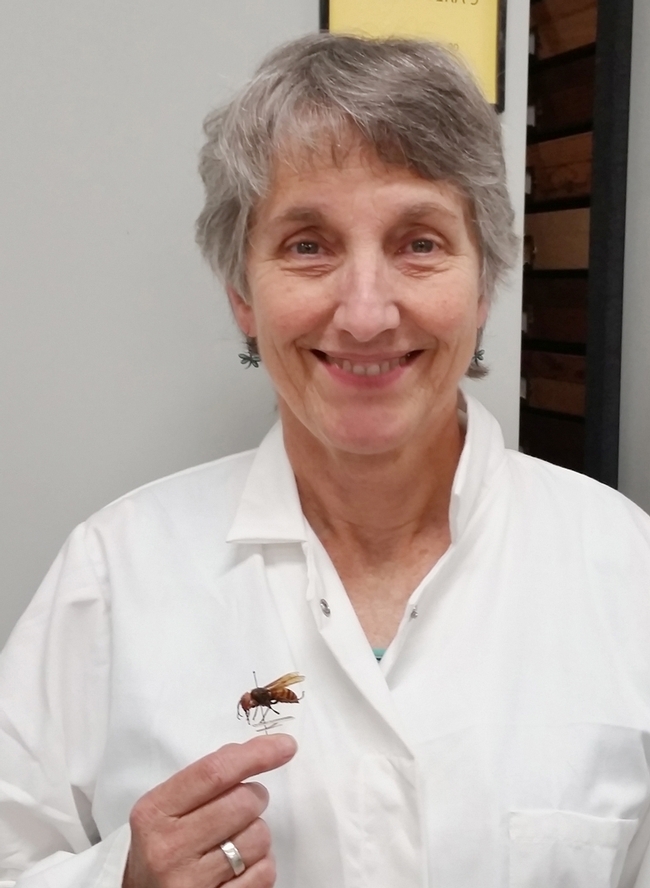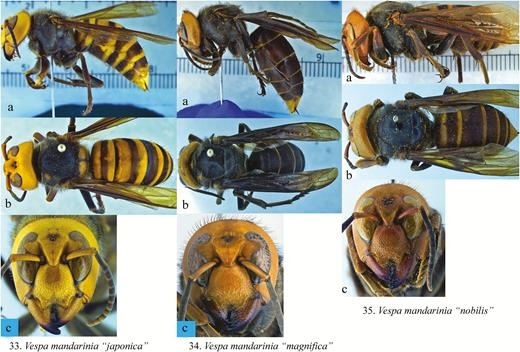
And timely, too!
While many folks are panicking about the first detected (and destroyed) colony of Asian giant hornets, aka “murder hornets,” in North America, three entomologists have just published research on this and the 21 other known species of hornets in the genus Vespa, in the journal Insect Systematics and Diversity.
The article, “The Diversity of Hornets in the Genus Vespa (Hymenoptera: Vespidae; Vespinae); Their Importance and Interceptions in the United States,” is the work of three entomologists: lead author Allan Smith-Pardo, U.S. Department of Agriculture Animal and Plant Health Inspection Service (APHIS); and co-authors James Carpenter of the American Museum of Natural History's Division of Invertebrate Zoology, and Lynn Kimsey, director of the Bohart Museum of Entomology and professor of entomology at UC Davis.
North America's first known colony of the Asian giant hornet, Vespa mandarinia, was detected (and, yes, destroyed) in September 2019 on Vancouver Island, British Columbia. A single V. mandarinia was found dead in Blaine, Wash., in December 2019.
“Hornet species identification can be sometimes difficult because of the amount of intraspecific color and size variation,” the authors wrote in their abstract. “This has resulted in many species-level synonyms, scattered literature, and taxonomic keys only useful for local populations. We present a key to the world species, information on each species, as well as those intercepted at United States ports of entry during the last decade.”

Vespa species are “primarily predators of other insects, and some species are known to attack and feed on honey bees (Apis mellifera), which makes them a serious threat to apiculture,” the authors wrote in their abstract.
In the USDA-funded research, the trio combed through scientific literature and museum collections to separate the species. They list their sources and offer insights on the distribution of each hornet, and a discussion.
The Asian giant hornet's distribution is India, Sri Lanka, Bhutan, Nepal, Myanmar, Thailand, Laos, Vietnam, Malaysia, Malaya, China, Hong Kong, Taiwan, eastern Russia, Korea, Japan (including Ryukyus), the authors wrote.

The Bohart Museum of Entomology, home of a global collection of nearly eight million insect specimens, houses 20 specimens of V. mandarinia. The largest one, a queen, measures about an inch and a half long, Kimsey said.
“Insects introduced in the United States often come in cargo boxes from Asia to U.S. ports, establish colonies, and expand their range,” she said.
The only known European hornet to colonize the United States is Vespa crabro, introduced on the East Coast in the 1800s. “It is now fully established in the southeastern U.S,” Kimsey said. “A decade or more ago, there was a colony of another species, Vespa asiatica, reported near the Port of Long Beach but nothing ever came of that.”
What's next for the research team? "We will be continuing to create online identification tools and a detailed website," Kimsey said.
Research Conclusion:
"From 2010 to 2018, there have been close to 50 interceptions of Vespa (hornets) and Vespula (yellow jackets (Vespula) at U.S. ports of entry. Little less than half of those interceptions were hornets. The Vespa species intercepted include V. bellicosa, V. crabro, V. orientalis, V. mandarinia, and V. tropica. One of the interceptions of significance was an entire nest of V. mandarinia containing live brood and pupae that was sent via express courier from Asia. All species of Vespa, except V. crabro, which is already introduced into the eastern United States, are considered of quarantine importance by the USDA-APHIS."
A website, Invasive Hornets, part of a cooperation between the USDA, Animal Plant Health Inspection Service (APHIS), Plant Protection and Quarantine (PPQ) and the University of Georgia, is taking shape. According to the journal article: "This website contains more than 1,000 stacked, high-quality images of all the species and most of the races of the genus Vespa. It is important to have the resources for the identification and prevention of introduction of non-native species and to understand the potential effects of invasive hornets in our ecosystems. Hornets are dangerous for the beekeeping industry because they can alter pollination in agriculture and disrupt the beekeeping industry, as well as create public health and safety problem."
The authors credited senior museum scientists Christine Lebeau of the American Museum of Natural History and Steve Heydon of the Bohart Museum of Entomology “for helping to process the loan of Vespa material.” Mary Burns of the National Identification Services (NIS) of the USDA-APHIS- Plant Protection and Quarantine (PPQ) provided information about the number of interceptions of Vespa at U.S. ports of entry.
In an article posted in Entomology Today, science writer-educator Leslie Mertz wrote that the team is "building a publicly available, online adjunct to the newly published key that uses menus of distinguishing characteristics, as well as illustrations and photographs. They hope to have the online key up and running in 2021.”
Attached Images:
